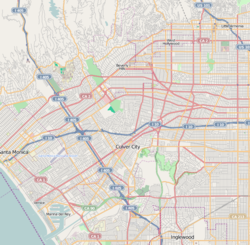Park La Brea, Los Angeles, California
| Park La Brea | |
|---|---|
| Neighborhood of Los Angeles | |
| Location within Western Los Angeles | |
| Coordinates: 34°03′57″N 118°21′15″W / 34.06583°N 118.35417°W | |
| Country | United States |
| State | California |
| County | Los Angeles |
| City | Los Angeles |
| Time zone | PST (UTC-8) |
| • Summer (DST) | PDT (UTC-7) |
Park La Brea (Spanish: La Brea - The tar, after the nearby La Brea Tar Pits) is a sprawling apartment complex in the Miracle Mile District of Los Angeles, California. With 4,255 units located in eighteen 13-story towers and thirty-one 2-story "garden apartment buildings", it is the largest housing development in the U.S. west of the Mississippi River. It sits on 160 acres (0.65 km2) of land with numerous lawns.
Park La Brea is bounded by 3rd Street on the north, Cochran Avenue on the east, 6th Street on the south, and Fairfax Avenue on the west. The complex is notable for its octagonal street layout, with many thoroughfares at a 45° angle of displacement relative to the English street grid.
After the arrival of the Spanish in the 1780s and the displacement of the area's indigenous population, most of the area that is now Park La Brea became part of the Rancho La Brea land grant, and remained largely devoted to agriculture and petroleum production well into the 20th century. The growth of Hollywood and the Miracle Mile made the adjacent areas desirable centers for residential development in the 1920s, but the mid-rise apartment towers that give the district its current name were built later, between 1944 and 1948.
Park La Brea represents something of a historical anomaly, having been built at a time when most visions of Los Angeles' development were dominated by low-rise tracts of single-family houses along freeway corridors. As the towers are relatively isolated from the rest of the Miracle Mile — set far back from major thoroughfares in a nod to Le Corbusier, they developed a reputation as "the projects", since they are reminiscent of such notorious housing developments as Chicago's Robert Taylor Homes and New York's Queensbridge. The street layout was created in a masonic pattern as a reference to the masonic heritage of the Metropolitan Life Insurance Company, which built the complex toward the end of World War II and immediately thereafter. After a period of decline in the 1970s and 1980s, the complex was refurbished in the early 1990s.
...
Wikipedia

